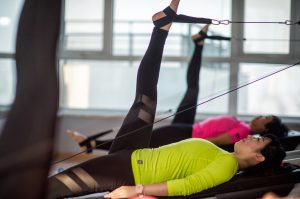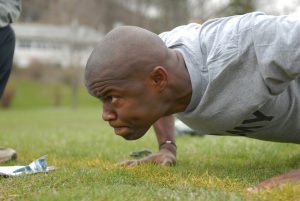The new year is here, so brace yourself for the in-your-face onslaught of gym membership deals. Not that there’s anything wrong with going to a gym to stay fit (or with getting a good deal, for that matter), but just because you’re paying for a gym membership, doesn’t mean you’re going to get motivated to travel there, or that you’re magically going to get in shape. After all, up to 67% of gym memberships go completely unused! So if you’re having trouble getting motivated to go out and find a fitness class that fits with your schedule, or to drive to a gym so you can jump on a boring cardio machine, what can you try to get yourself into the exercising groove? We’ve got a great idea to give yourself a jump start: give yourself a goal to work towards and spark your sense of competition, by doing a fitness challenge!
What Is a Fitness Challenge?

Fitness challenges can be summed up pretty simply: you commit to doing some form of exercise every day for a month. It could be based around a certain body part or targeted exercise (like squats), or around improving a certain area of your fitness (like endurance or strength), and could include things like planks, squats, running, HIIT, abs, etc etc.
How do you start? Well, depending on your fitness level, you’ll probably start small at the beginning of the month, but will try to up the stakes a little bit each day, until you’ve completed the challenge. That means you’ll gradually increase the time, reps, distance, weight, etc until you’ve reached your goal at the end of the month. For example, you might start a plank challenge by holding plank for 20 seconds on the first day, but you might end up being able to hold that position for over 2 minutes by the end!
Why Do a Fitness Challenge?
We know that any kind of exercise is good for you, but what are the specific benefits of putting yourself to the test physically for a month? Other than an increased level of fitness (and remember, 30 days is not enough time to make you a super athlete or give you an insane 6-pack, but it’s a good start!), a fitness challenge can help you:
- Get motivated – Like we said, if you’re a beginner, 30 days is not going to completely transform you, but that doesn’t mean it’s not worth doing! Just think how you’ll feel after completing the 30 days, and not just because of the endorphins that you’ve released. You’ll have reached a goal, whether it’s losing weight, getting stronger, or just taking time to focus on you. You’ll probably feel so good that you’ll want to keep going!
- Form a habit – The old saying used to be that it takes 21 days to form a habit, but it turns out that, according to research, it really takes 66 days on average. So 30 days might not be the truly scientific amount of time needed to get you on the workout wagon, but it is an excellent start: you’ll be around halfway there! And, according to Mike Siemens, Corporate Exercise Physiology Director at Canyon Ranch, “It takes about 3 to 4 weeks for people to start feeling really good while exercising so if you can get over that first 3-week hump of physical adaptation things get a lot more fun and pleasant, which increases likelihood of sticking with it.”
- Find a flexible workout model that fits into your life- A fitness challenge can be whatever you want or need, and can help you reach your goals whether you’re a total novice or seasoned exerciser, or even if you have no equipment at home or can only squeeze in 10 minutes at a time. For example, avid runners can choose a challenge that pushes them out of their comfort zone, while those who’ve always wanted to start can try a “couch to 5K”-type challenge. After all, one study found that even jogging for 5-10 minutes a day can reduce your risk of heart disease, so, again, you might not shed an astonishing amount of weight, but you’ll be doing something positive for yourself.
Which Challenge Is Right for You?
There are tons of ideas out there for fitness challenges to try: some you can design yourself with a little help from fitness-focused websites, some are app-based, some are basically virtual classes run by fitness studios, and some are even social media challenges that encourage you to “compete” with others. Head to the internet with an idea of your goals and check out some ideas for what might work for you!
Looking for a simple way to start on your fitness challenge journey? The following are some of the most popular types of fitness challenges out there, with some caveats for how to best approach them:
30-Day Squat Challenges
Lots of people looking to boost their booty have tried a 30-day squat challenge to get them going, with some opting to start with, say, 20 squats a day and working up to 200 a day. You’ll definitely burn some calories and strengthen muscles in your lower body doing this, but we recommend a variation on this challenge. Instead of focusing on being able to do endless reps, it’s probably more beneficial to do 100 squats a day, but vary them. For example, do 10 of each with different foot positions (toes turned out, narrow, wide, etc), do 10 of each of those as jump squats, add weights (10 backloaded, 10 frontloaded, and 10 at your sides), etc.
It’s also important that you do a body-part-focused challenge like this as a part of a more all-encompassing exercise regime (just remember to cut out the lower body work, as you’ll be getting plenty of that with your squat challenge!). In addition, you should consider doing this challenge every other day to give your glutes a rest.
30-Day Plank Challenges
Looking to tighten your core? Add a plank challenge into your day (again, hopefully as a supplement to a more varied exercise regime). This one seemingly simple static move is a powerhouse, working lots of muscles, but you can still do it everyday. Many people start this challenge by doing, say 10 – 20 seconds of plank everyday (or even starting on their knees), then very gradually increasing their time until they can hold plank for 1 – 2 minutes at a time. As with the squat challenge, we also recommend making this one your own, and varying the one base move, with things like commando planks (or up-downs) or plank hip dips.
Remember to go slow with this one, and use perfect form, or you could end up with neck, shoulder, or back pain.
30-Day HIIT Challenges
If you want to get some serious benefits in a short amount of time, try a HIIT, or high-intensity interval training, challenge. Research suggests that this type of workout, which gets your heart rate up by having you move quickly between exercises with little down time, might outperform traditional cardio when it comes to fat loss and other benefits. HIIT workouts can be cardio, or strength training, or a combination of both, and because they’re so intense you can usually get away with doing only 20 minutes or less.
Be careful if you’re a beginner: remember to warm up and cool down (many of these short HIIT workout challenges don’t include either), start small, maybe by sticking with a plan that is focused on one type of cardio, like alternating walking with bursts of running, and ALWAYS make sure you’ve got your form down. If you’re more advanced, look for something that alternates high cardio (like high knees or plyometrics) with strength moves like pushups or squats and lunges – or for a fun throwback to your childhood (that will also leave you gasping for air and your muscles burning), try a 30-day HIIT jump rope challenge.
30-Day Burpee Challenge
This is a pretty self-explanatory one! You’ll pretty much be doing burpees, or squatting down, jumping into plank, doing a pushup, jumping your feet back in, and jumping up in the air, every day for 30 days, either choosing one number to complete each day or (if you’re a beginner) starting out with a few each day and gradually increasing your reps. Burpees are one serious total-body move, and you’re sure to see some benefits from doing them for a month! Again according to Siemens, “Burpees are a great total-body exercise. They get the heart rate up quickly, and train coordination, muscle endurance and power all at the same time.”
As with the other types of exercises, if you’re already familiar with burpees, vary your movements to get maximum benefits: try star burpees, side burpees, broad jump burpees, one-legged burpees, burpees with weighted upper body moves at the top, etc. And if you’re a beginner, again, be very careful with this move: doing an intense 5-in-1 move like burpees every day can wreak havoc on your joints, especially if you push yourself too hard, too soon. Try modifying at first by stepping back into plank, doing pushups on your knees, doing high-knee steps instead of jumps, etc.
The On-the-Hour Challenge
This type of challenge is a little different from the others, and probably not as popular or as well known, but it’s a fun and innovative way to get you moving during the day (especially if you’re working from home). Basically, you break your workout up into, for example, 8 mini workouts that are spaced throughout the day: every hour, on the hour, you’ll do, for example, 30 seconds to a minute of various exercises. Great if you can’t find a half an hour altogether to work out; also great to remind you to get you off your butt and move during your work day!
The One-Punch Man Challenge
We had to throw this one in for all of you advanced exercise buffs out there! Inspired by a Manga character who’s supposed to be the strongest man in the world, it’s a circuit of basic, but tough, moves done at high reps. For 30 days, you’ll do: 100 pushups, 100 sit ups, 100 squats, and run a 10K. Sound completely unachievable? You can start with 50 reps of each and a 5K and work your way up. The obvious caveat here is that this challenge is only for those who already have a high level of fitness.
How Can You Succeed?
Once you’ve picked your challenge, there are some things to remember to get the most out of it, and to give you a feeling of success that will keep you moving after the month is over:
- Don’t put all of your eggs into one fitness basket – Remember that it’s important to focus on your overall fitness, as well as your nutrition. According to Trevor Thieme, CSCS, “…[M]ost challenges—especially highly focused ones like abs or squat challenges—aren’t substitutes for a well-designed training plan; they should be completed in addition to one. So choose your challenge wisely, making sure that you can integrate it easily into your existing program or that it really can stand alone, as might be the case if the goal is to, say, complete 30 workouts and recovery sessions in 30 days.”
- It’s OK to miss a day – In fact, you should be taking rest and recovery days to allow your muscles to rebuild. You can always tack on extra days to the challenge or add on to the next day’s workout.
- Make it a part of your lifestyle – Pick a time that is good for you to do it (a good idea is to do it as soon as you get up, so you don’t lose motivation, but we get that that’s not always possible) and commit to making it a routine you won’t forget to do – or won’t tell yourself you’ll do later!

- Give yourself a visual aid of your progress – Have a calendar or checklist you can see so that your visible progress keeps you motivated.
You can get your sweat on in so many different ways – you don’t have to force yourself into a workout plan that you find inconvenient, intimidating, or unmotivating. If a fitness challenge feels like a way to start your new year off right, give one a try, but don’t forget to keep that motivation going throughout the year. You might find that the stressful pressure to create a “new year, new you” will turn into a long-term commitment to your health. And don’t forget to share your results!